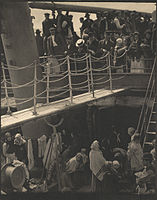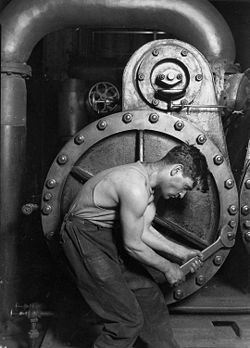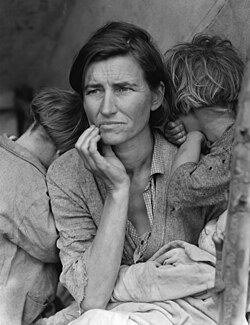Přímá fotografie
Přímá fotografie (neboli fotografia diretta nebo straight photography) je fotografický směr, který prosazuje realistickou fotografii bez jakékoliv manipulace nebo technického zkreslení. Fotografie nejsou rozmazané, objekty jsou zobrazené ostře, s přirozenými barvami (tóny) a světlem. Jedni z prvních přímých fotografů byli Alfred Stieglitz a Paul Strand na počátku 20. století. Za propagátora přímé fotografie se považuje Skupina f/64 (okolo r. 1932).
Důležití představitelé
- Alfred Stieglitz pořídil v roce 1907 fotografii nazvanou Mezipalubí (resp. Podpalubí, anglicky The Steerage) při své cestě lodí z USA do Evropy a otiskl ji roku 1911 ve fotografickém časopise Camera Work. Snímek je považován za jeden z prvních nového moderního směru tzv. přímé fotografie, tedy realistické fotografie bez jakékoliv manipulace nebo zkreslení. Jedná se o jednu z jeho nejvýznamnějších fotografií, ceněnou zároveň jako jednu z největších všech dob, protože zachycuje v jediném obrazu informativní dokument své doby a zároveň jednu z prvních prací uměleckého modernismu.
Lewis Hine: Mechanik pracující na parním stroji, 1920
Dorothea Langeová: Matka přistěhovalkyně (Migrant mother), 1936
Média použitá na této stránce
Lewis Hine, 1920. Power house mechanic working on steam pump.
Records of the Work Progress Administration. (69-RH-4L-2)
Lewis Hine's 1920 Power house mechanic working on steam pump, one of his "work portraits", shows a working class American in an industrial setting. The carefully posed subject, a young man with wrench in hand, is hunched over, surrounded by the machinery that defines his job. But while constrained by the machinery (almost a metal womb), the man is straining against it—muscles taut, with a determined look—in an iconic representation of masculinity.Portrait shows Florence Thompson with several of her children in a photograph known as "Migrant Mother". The Library of Congress caption reads: "Destitute pea pickers in California. Mother of seven children. Age thirty-two. Nipomo, California." In the 1930s, the FSA employed several photographers to document the effects of the Great Depression on the population of America. Many of the photographs can also be seen as propaganda images to support the U.S. government's policy distributing support to the worst affected, poorer areas of the country. Lange's image of a supposed migrant pea picker, Florence Owens Thompson, and her family has become an icon of resilience in the face of adversity. However, it is not universally accepted that Florence Thompson was a migrant pea picker. In the book Photographing Farmworkers in California (Stanford University Press, 2004), author Richard Steven Street asserts that some scholars believe Lange's description of the print was "either vague or demonstrably inaccurate" and that Thompson was not a farmworker, but a Dust Bowl migrant. Nevertheless, if she was a "Dust Bowl migrant", she would have left a farm as most potential Dust Bowl migrants typically did and then began her life as such. Thus any potential inaccuracy is virtually irrelevant. The child to the viewer's right was Thompson's daughter, Katherine (later Katherine McIntosh), 4 years old (Leonard, Tom, "Woman whose plight defined Great Depression warns tragedy will happen again ", article, The Daily Telegraph, December 4, 2008) Lange took this photograph with a Graflex camera on large format (4"x5") negative film.[1]





